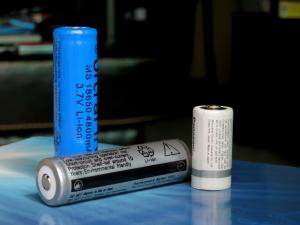Cobalt Poor and Rich lixNi1-yCoyO2 Layered Materials For Li-Ion Battery Application

Copyright : Wikimedia
Layered compounds are being investigated extensively due to their high theoretical specific capacities and relatively good cyclability. The electrochemical performance of a layered cathode material depends, to some extent, on the lattice parameters and structural stability of the crystal framework as well as, to a large extent, on the cation ordering of the compounds.
Lithium cobalt oxide (LiCoO2) is an excellent cathode material but expensive, toxicity and not abundant in nature. Therefore, it is logical to produce materials with less Co content for commercial application.
LiNiO2 has the advantage of being cheaper. However, it is unstable and do not exhibit good electrochemical properties. Substitution of Co with Ni may improve the structural stability of LixNi1-yCoyO2 system and may reduce production cost due to the least of Co content.
Many groups of researchers have attempted to synthesize some stoichiometries of LixNi1-yCoyO2, but their XRD results show the presence of impurities. Other researchers have produced hexagonal structure but with poor cation ordering with high (104) peaks relative to the (003) peak.
In this work, layered LixN1-yCoyO2 (x= 1.0, 1.05, 1.1: y= 0.0, 0.1, …., 0.5) via a novel self-propagating combustion synthesis and its electrochemical properties are investigated. The most obvious advantage of using this combustion route is the ease of the method and speed of the reaction which is over in a few seconds. The precursors are already in the dry form, and, subsequently, the thermal annealing can be done directly without further drying or precalcination process.
Therefore, the synthesis method has the advantage of producing homogeneous materials with the resulting final products free from impurities, even for the Ni-rich stoichiometries. Simultaneous Thermogravimetric Analysis (STA), X-Ray Diffraction (XRD) , Field Emission Scanning Electron Microscopy (FESEM) and Energy DIspersive X-Ray Spectroscopy were used to characterize all the materials. The characterization of all samples shows pure and single phase layered hexagonal structured materials obtained at 700 degree celcius for 24 h, 48 h and 72 h with a polyhedral like morphology. This means that the Ni-ions have been successfully substituted in the LiCoO2 structure.
It can be clearly observed that all of the fingerprint peaks, namely, (003), (101), (006), (012), (104), (018), and (110) are easily identifiable in all of the XRD patterns. All the diffraction peaks can be indexed with alfa-NaFeO2-type structure based on the hexagonal crystal system with R-3m space group. They are isostructural with LiNiO2 and LiCoO2 phases as compared with the XRD patterns in the ICDD database. The EDX results give atomic percent for each sample and agreeable to calculated synthesized values, from cyclic voltammetry, the maximum voltage can reached up to 5.0 V and minimum voltage is 2.3 V.
The LixNi1-yCoyO2 materilas show good promise as cathode materials. The best performance of cathode materials are LiNi0.5Co0.5O2 with the specific capacity of 158.2 mAh/g, Li1.05Ni0.6Co0.4O2 with the specific capacity of 155.3 mAh/g, Li1.05Ni0.7Co0.3O2 with the specific capacity of 153.9 mAh/g, Li1.05Ni0.7Co0.3O2 with the specific capacity of 148.1 mAh/g, Li1.1Ni0.6Co0.4O2 with the specific capacity of 145.7 mAh/g, LiNi0.7Co0.3O2 with the specific capacity of the 144.4 mAh/g, Li1.1Ni0.7Co0.3O2 and Li1.1Ni0.5Co0.5O2 with the specific capacity of 142.8 mAh/g.
Professor Dr.
CHE NORLIDA BINTI KAMARULZAMAN
Universiti Teknologi MARA, Selangor
Institute of Science
INSTITUTE OF SCIENCE (IOS)
norlyk@salam.uitm.edu.my
Media Contact
All latest news from the category: Power and Electrical Engineering
This topic covers issues related to energy generation, conversion, transportation and consumption and how the industry is addressing the challenge of energy efficiency in general.
innovations-report provides in-depth and informative reports and articles on subjects ranging from wind energy, fuel cell technology, solar energy, geothermal energy, petroleum, gas, nuclear engineering, alternative energy and energy efficiency to fusion, hydrogen and superconductor technologies.
Newest articles

Properties of new materials for microchips
… can now be measured well. Reseachers of Delft University of Technology demonstrated measuring performance properties of ultrathin silicon membranes. Making ever smaller and more powerful chips requires new ultrathin…

Floating solar’s potential
… to support sustainable development by addressing climate, water, and energy goals holistically. A new study published this week in Nature Energy raises the potential for floating solar photovoltaics (FPV)…

Skyrmions move at record speeds
… a step towards the computing of the future. An international research team led by scientists from the CNRS1 has discovered that the magnetic nanobubbles2 known as skyrmions can be…





















